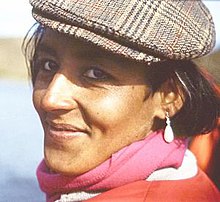Exercise Paddington Diamond

Exercise Paddington Diamond was a joint Bolivian-British-Swiss scuba diving expedition to Lake Titicaca in 1987.[1]
Background
In early 1987 the
Exercise Paddington Diamond was a collaborative venture hosted by the
A subsidiary objective of Paddington Diamond was to use the planned dive programme to increase understanding of the Lake Titicaca environment by conducting underwater surveys of localised regions to seek submerged Inca or other ruins, and by undertaking detailed collections of animal and plant life using the precision only possible with the use of scuba techniques.
The British party comprised diving personnel from a range of
Timetable
After two days of acclimatisation to altitude in La Paz the European members moved up to the lake on 5 May 1987 and joined the navy group who had set up a tented camp on the shore at Santiago de Ojje. Diving commenced the following day and continued up to and including 11 May. In this period there were 34 logged expedition dives varying in depth from 2m to 21.5m and in duration from 4 minutes to 45 minutes.[e][f]
After two rest days, on 14 May the expedition moved to Challa Bay on the Island of the Sun. Diving commenced here on the 15th and continued up to and including 27 May with a rest day on the 21st. At Challa there were 99 logged dives varying in depth from 4m to 38m and in duration from 3 minutes to 66 minutes.[g]
Results
Primary Objective
The dive tables and computers were tested during a range of dive types, after which the two designs of computer were cross referenced and checked against the recommendations of the new Bühlmann tables. Many dives were deliberately planned to employ a rectangular profile, the form best suited to match the assumptions of the calculations and act as a test of the decompression recommendations. Survey and habitat sampling dives differed in that they often began and ended on shore and were not controlled profiles.[h] They were also shallower than many of the dives made specifically to test the tables and computers.
After each dive the returning divers were subjected to a regime of medical examinations to check for early signs of nitrogen bubbles forming in the body (the cause of decompression sickness, ‘the bends’). No signs of decompression problems were found.
Following this programme of dives the Bolivian Navy officially adopted the new Bühlmann tables for all diving operations at altitude.
Subsidiary objectives
No new ruins, structures or Inca artefacts were discovered during the expedition but many scientifically valuable biological collections and observations were made, especially of the smaller
Media
Throughout the expedition there had been media coverage in the UK press and on Bolivian television and radio. After the expedition Services Sound and Vision Corporation (SSVC) produced a 20-minute television news documentary about the expedition for broadcast on the British Forces Broadcasting Service (BFBS), which also ran radio items.[j]
The first women to dive in Lake Titicaca?

On Thursday 7 May 1987 the expedition's Swiss nurse Annie Jean-Alexis made a brief 4 minute dive to a depth of 2m, abandoned for technical reasons. Nevertheless, she was possibly the first woman to dive in Lake Titicaca. Two days later she made a more successful descent to a depth of 3m for 15 minutes.[k]
Also on 9 May two women dived during a visit by the UK Naval Attaché and his staff.[l] As this diplomatic party was not undertaking expedition work dives, the logs for these dives are not reproduced in the published report and the names of the two divers are not recorded there. However, in the unpublished diary of an expedition member it is noted their first names were Sylvia (or Silvia) and Marita.[m] Sylvia/Silvia was a member of the British embassy staff; Marita was a Swedish volunteer worker known to the embassy.
On 17 May Sarah Last, a PR executive from BAOR, made a 15-minute dive to 6.4m during a visit by a media team from the SSVC who had joined the expedition for several days to produce TV and radio news programmes.[n]
Therefore, during Exercise Paddington Diamond at least four women dived with
Notes
- ^ As was usual for BAOR exercises.
- ^ Armada Boliviana.
- ^ Noted in the interview with Captain Marc Moody RAOC, the BAOR Expedition Leader, in the Services Sound and Vision Corporation film of the expedition
- ^ 'Public outreach' is an active engagement with the public to convey information regarding, and generate interest in, what you are doing, while gaining a greater understanding of the public's perceptions and concerns regarding that activity.
- bottom time.
- ^ BAOR pp. 15–21.
- ^ BAOR pp. 22–39. A dive recorded as 82 minutes (BAOR p. 38) included time spent in an air pocket in an underwater cave according to the unpublished report of the expedition’s chaplain. Report seen by the first contributor to this Wikipedia entry.
- ^ i.e. The divers moved freely underwater, changing depth as they followed the contours of the lake bed.
- ^ BAOR pp. 59-63
- ^ e.g. UK newspaper The Daily Telegraph 5 May 1987; Bolivian radio 29 May 1987.
- ^ BAOR report pp. 18–19
- ^ BAOR report p. 7
- ^ Diary seen by the first contributor to this Wikipedia entry.
- ^ BAOR report p. 26
References
- ^ [BAOR] (1988). Exercise Paddington Diamond. Printing Section, Ordnance Services, BAOR: Viersen (BFPO 40), West Germany. pp. i-iv, 1-78. (This report has no stated author and is not dated. As a consequence it is often cited as ‘Exercise Paddington Diamond. May 1987’, the date of the Exercise. It was a BAOR report and appeared in print in early 1988).
